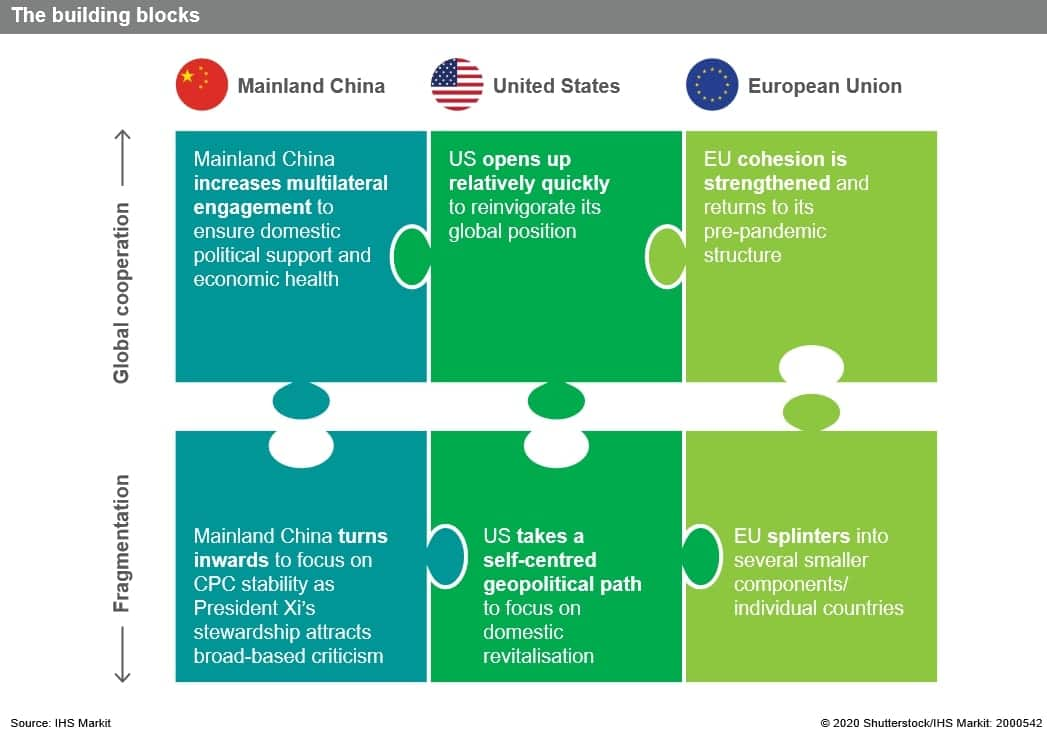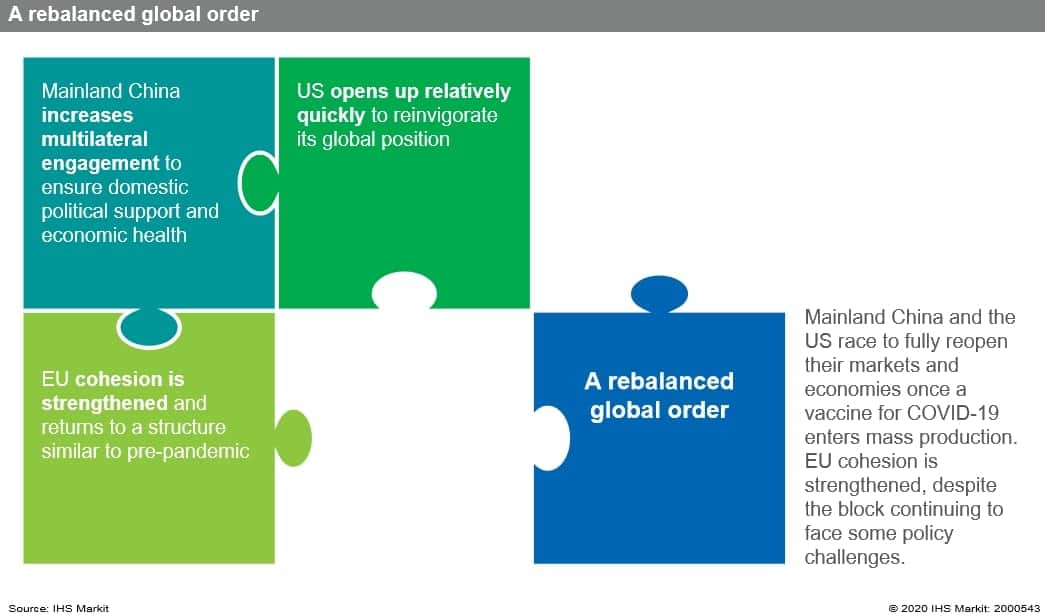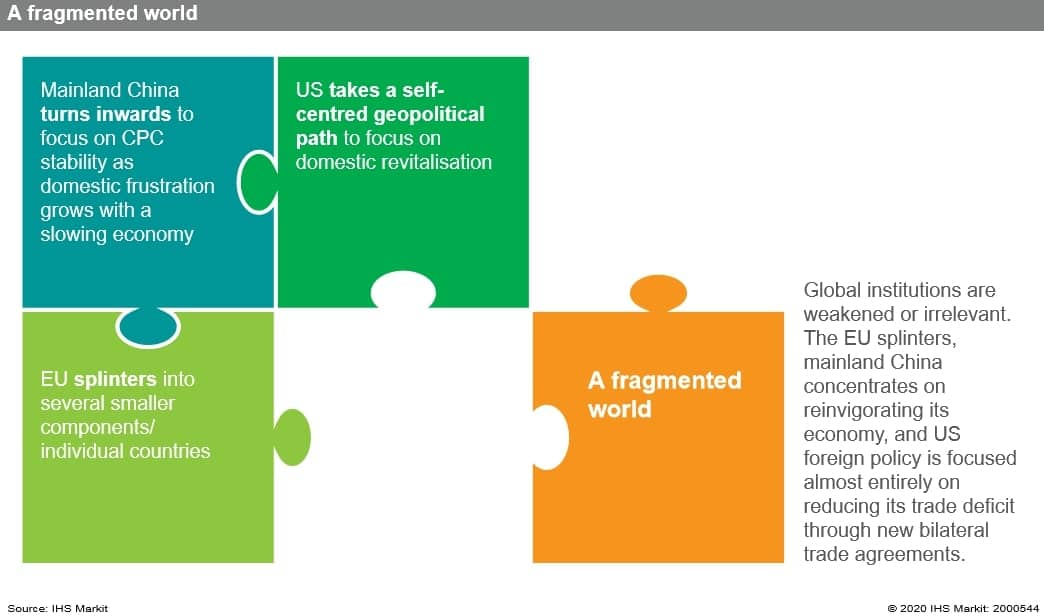Geopolitics in a post-pandemic world – Scenarios for 2025
With the coronavirus disease 2019 (COVID-19) pandemic disrupting all facets of everyday life, we have begun to consider the long term impacts the crisis could have on global state relations. While it is possible that the world will go back to how it was in December 2019, it is also possible that more substantive geopolitical shifts will disrupt the status quo.
In our view, it is important to take stock of our assumptions about the world now and how they might change so that companies and investors can be better prepared for the longer-term disruption. With that in mind, we have produced the 'Geopolitics in a post-pandemic world - Scenarios for 2025' report to begin thinking about what form that disruption could take.
Constructing scenarios
We adopt a ' scenarios' approach when examining potential disruption. Scenarios, by definition, involve a series of events that could happen, rather than those that will happen. We find the most useful scenarios to be the ones that are credible and realistic but not necessarily the most probable. In fact, scenarios that test mutually exclusive outcomes give us the best insight into what impacts we may have to plan for that otherwise may have been overlooked or downplayed. To construct our scenarios, we first consider the 'building blocks' that set out possible actions taken by key geopolitical actors. Combining the various building blocks in different configurations produces different global scenarios, each of which test different dimensions of geopolitics.

For this report, we focused on our two most extreme scenarios (Global cooperation vs Fragmentation) to look at the range of potential outcomes and help stimulate discussion on how different sectors and businesses will be impacted.
Scenario 1- A rebalanced global order
Our first scenario assumes that Mainland China and the US race to fully reopen their markets and economies once a vaccine for COVID-19 enters mass production. We also assume that EU cohesion is strengthened post-pandemic, despite the block continuing to face some policy challenges.

As a result, most countries and regions embrace policies of cooperation and multilateralism to manage the fallout of the COVID-19 pandemic and to mitigate similar shocks going forward. The rivalry between the US and China persists, but issues deemed of global criticality are designated as cooperation areas through revamped multilateral organisations. Both China and the US ramp up their foreign engagement, the former by increasing its funding of and participation in multilateral organisations, and the latter re-joining institutions it has scaled back support for. The EU, which successfully completes the Brexit transition process, introduces some reforms that help ease the block's current fault lines and increases its financial support to its Eastern member states.
Scenario 2 - A fragmented world
In our second scenario, we assume that the pandemic has weakened global institutions or made them irrelevant. The EU splinters, mainland China concentrates on reinvigorating its economy, and US foreign policy is focused almost entirely on reducing its trade deficit through new bilateral trade agreements.

In this world, the US, China, and the EU are pre-occupied with internal pressure, dissent, and instability and decide to eschew global solutions in the face of unprecedented challenges. As a result, each of these actors sees a sharp turn to isolationist, protectionist economic policy that in turn weakens many global institutions and decreases trust between states. Governments around the world follow this lead by implementing policies to re-shore supply chains and control the supply of essential goods, largely through new regulations and tariffs. This new global dynamic makes EU cohesion untenable, leading to a breakup of the union into smaller blocks and alliances.
Thinking about scenario impact
In addition to providing us with a view towards possible future geopolitical events, by constructing scenarios we are also able to assess how the risk landscape may change across different regions of the world, and thereby begin to develop plans to mitigate them. For example, Scenario 1 would lead to a highly competitive international landscape, with regions such as Latin America and Sub-Saharan Africa potentially seeing increased competition for investment and influence from the US and China. In Scenario 2, the fragmentation of the global order is likely to increase risks related to international trade policy, with protectionist policies raising risks such as contract enforcement, contract alteration and tax inconsistency across Europe and the Asia Pacific region.
Helping clients get ahead of the future
The two scenarios outlined above, as well as their potential impacts, are fleshed out in detail in our 'Geopolitics in a post-pandemic world - Scenarios for 2025' report. While the report only focuses on these two scenario possibilities, the full scenario catalogue contains many more scenarios of varying probability and impact.
There are many ways of selecting and developing scenarios to help think through and inform planning for an uncertain future. If you have a scenario challenge, we would be excited to discuss it with you and develop an approach that provides you with the most practically useful outcome. Contact us to learn more or request the full report.



